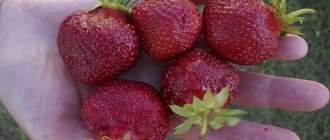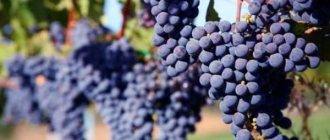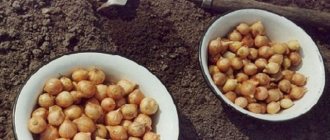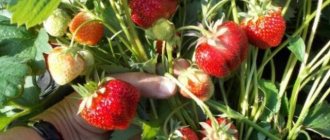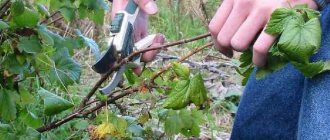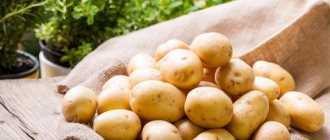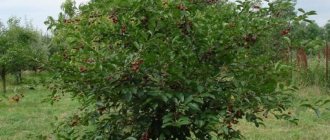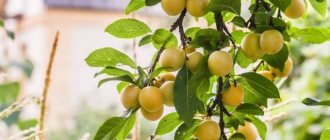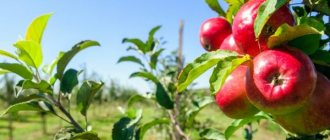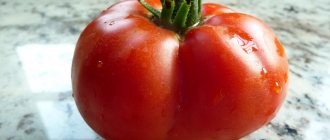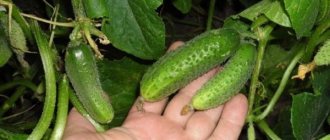Characteristic features of the variety
The nightingale is characterized by winter hardiness, resistance to diseases and pests, and good yield. Easy to care for. The berries have a pleasant sweet and sour taste and a pronounced strawberry aroma.
Bush size
The strawberry bush Nightingale is medium-sized, the height usually does not exceed 40 centimeters. The shape of the bush is round and very compact. Up to ten peduncles with a large number of flowers are formed on the bush. The peduncles themselves are very thin and long. They are found under the leaves and never grow above the level of the bush. The diameter of the bush can reach 60 centimeters.
Appearance of the leaf plate and tendrils
There are a lot of leaves on the bush, they can be either dark green or light green, and they grow in the first year after planting the berries. The color of the leaves, as well as their density, largely depends on the region where the plant is planted. Then, in the first year, strawberries throw out the maximum number of whiskers.
The mustache is a long arrow that spreads along the ground. Over time, a rosette forms on the tendrils, which can be used to propagate strawberries. In subsequent years, the number of whiskers decreases.
Flowering and pollination
A month passes from the beginning of flowering and pollination to the ripening of the fruit. Pollination occurs naturally in open areas. Nature does its own thing with the help of wind, rain and bees. If you grow strawberries in a greenhouse, you will have to take care of pollination yourself.
You can use a fan as a source of wind, and also transfer pollen from bush to bush with a brush.
Ripening time and yield
The Solovushka strawberry variety is considered mid-season. The exact ripening period depends on the region of planting and care conditions. Under favorable conditions, a warm climate and sufficient watering, it ripens around mid-June.
In the first year you can get 500 grams of berries from one bush. In subsequent years, this figure, with proper care, can increase to 1 kilogram. The berries on the bush ripen at the same time, which is very convenient when harvesting.
Fruit taste and transportability
The Nightingale berry has a round-conical shape, bright red color and a pleasant strawberry aroma. The taste is good, sweet and sour. In the first year, the fruits are especially large and can reach a weight of 50 grams. In subsequent years the berries are slightly smaller.
Resistance to adverse conditions
One of the advantages of the strawberry variety in question is its resistance to frost. If the ground is not covered with snow, then the Nightingale can withstand frosts down to -10 degrees. In snowy winters - up to 30 degrees below zero.
Immunity and susceptibility to disease and parasites
The Nightingale strawberry has a strong immune system and is resistant to many diseases and parasites. To many, but not to all: gray rot, white and brown spot are the diseases to which the Nightingale is most susceptible. It is necessary to follow the rules of caring for the plant and regularly inspect the leaves - this will help to start treatment on time and prevent the death of the plant.
Description of the vegetative form
Kupchikha bushes develop well by the end of the first year of life.
- Dredge bushes of the "Kupchikha" variety are of medium vigor, neat, compact, spherical.
- The variety is characterized by good foliage, while the leaves are not large and have a classic green color. But the appearance of the leaves themselves is very characteristic - they are very wrinkled and very ribbed, concave. The leaf is shiny, glossy, with a faint edge.
- The teeth of the leaf blade are blunt and rather wide. The middle lobe of the leaf is rounded, and the base of the middle part is obtuse and sits on a longer petiole than the lateral leaves. The petiole of the entire leaf is long, with a strong pubescence, the hairs are directed slightly downwards.
- Stipules are short, green and narrow.
- Those who have at least once seen this variety in the original will no longer be able to deceive and slip a fake, its leaves are very characteristic.
- The bisexual flowers are white, large, untwisted, and sit on long peduncles that are located at the level of the leaf blades. Peduncles are densely pubescent, of medium thickness. The inflorescence is multi-flowered, semi-spreading.
- The variety produces few whiskers; they are of medium length and dark red in color.
Berry
The berries of this variety attract with their unusual shape.
- The stalk is medium and thin. The cylindrical berry has a pronounced neck. Unfortunately, the photos that appear with the supposedly “Merchant’s Wife” do not always adequately reflect reality. And the variety itself tends to change in different regions.
- The color of the berry ranges from intense red to dark red. If the first forms of earthworms had an uneven color, sometimes with white tips, then “Kupchikha” is fully ripe, intensely, uniformly, and richly colored.
- The strawberry pulp is dark red, dense, elastic, and slightly juicy.
- Chemical analysis of the berries showed sugar levels within 5.8%, vitamin C - 79 mg%. The level of organic acids is 0.6%, which does not affect the taste, but creates unsurpassed harmony.
- The tasting commission recognized the taste as harmonious, balanced, and the aroma as persistent and long-lasting. The variety received a score of 5.0 points.
- The applicant, based on data collected from all regions, put the average weight of the berry at about 3.7 g, but the maximum figure was shown at 17 g.
- Processed berries are of particular delight. Being universal, it is perfect for the production of compotes and jam. When preparing dry jam (ground with sugar 1:2), which is usually made from wild berries, it is distinguished by a special delicacy. The aroma, taste, and aftertaste are so strong that they will not leave anyone indifferent.
Productivity
The productivity of "Kupchikha" depends on the region of growth, timely watering and warm weather.
Reviews from those who have already harvested and tasted strawberries are varied. Some claim that you can easily take 300 g from a bush, others that 500 g. However, the regions where the crop is cultivated are so different in climatic conditions that there is no point in dwelling on any figure.
It has long been established in strawberry productivity that the higher the temperature, with optimal humidity, the higher the yield, subject to balanced soil nutrition.
Planting strawberries Nightingale
This variety of strawberries needs to be planted in prepared soil. The seedlings must be young and healthy. Before planting, the roots should be treated. Bushes should not be located too close to each other.
See also
Description of the Primi variety strawberries, planting and care rules
Read
Site selection and preparation
The most suitable area for strawberries will be a well-lit place with neutral soil. To get a good harvest, do not plant the plant in the shade of trees. The structure of the soil should be light; for this you can add river sand to the soil.
If there is an excess of sand in the soil, then you need to correct this by adding clay.
After the planting site has been selected, it is necessary to add fertilizer to the soil. For one square meter you will need:
- compost bucket;
- 50 grams of mineral fertilizers;
- 1 liter of wood ash.
Only after this can the area be dug up.
Important: you need to prepare the beds in advance so that the soil settles. It is best to do this two weeks before planting.
How to choose seedlings
In order not to make a mistake in choosing seedlings, you need to carefully examine them before purchasing. Old seedlings have a coal-black root system. Young plants have light brown roots. If the seedlings were planted in light soil, the root system will be more developed. If the seedling is flowering, then the first harvest can be harvested already in the year of planting. If there are no flowers, then the plant will begin to bear fruit only in the next season.
Planting layout
There are several schemes for planting strawberries. In the first year, it is better to plant it according to a single-line scheme, since at this time the Nightingale throws out a lot of whiskers. In this case, the distance between the rows reaches 90 cm, and between the bushes - 20 cm. Over time, new rosettes can be planted in the free space between the rows. You can also plant this variety of strawberries in separate bushes. In this case, the distance between them can reach 50 cm. This planting scheme gives a large harvest and a low probability of disease.
Timing and technology of planting seedlings
You can plant seedlings in spring, summer, and even autumn. In the spring, the number of established seedlings will be much higher than when planted in the fall. It is best if onions, beets, parsley, and lettuce grow nearby. Before planting, strawberry roots need to be treated. For 10 liters of water add 40 g of salt and 7 g of copper sulfate. Place the seedlings in this mixture for half an hour, and then rinse the roots. Dig shallow holes in previously prepared soil, plant the plant there and cover the roots with soil. After this, the seedling is watered and mulched.
Description
Deciding to grow a new strawberry variety is not easy. You definitely need to get acquainted with the description, characteristic features of the bush and berries.
Bushes
The bushes of the remontant strawberry variety Solovushka are distinguished by their strong growth. They are compact, round, with a large number of rich green leaves, and they grow in size already in the first year after planting.
The Nightingale has 7-9 thin, long peduncles with numerous buds on each bush of the first year of life. On two-year-old bushes there are up to 20 pieces. They are spreading, located below the foliage. Due to their thinness, the flower stalks cannot hold ripening berries, so it is advisable to mulch the beds.
Abundant weed formation on the plantings of the first year; it is during this period that the Nightingale strawberry should be propagated. In subsequent years, few whiskers are formed.
Advice! To obtain high-quality planting material to replenish new strawberry beds, it is better to grow mustache on selected mother bushes.
Berries
The shape of large, up to 50 g, round-conical berries. Moreover, the berries of the first wave are almost twice as large as the subsequent ones. The fruits of the Solovushka variety are rich red and shiny. The achenes are yellow, medium in size, located almost on the surface of the berry.
The pulp is juicy, bright red, not too dense, but not watery either. There are strawberries with an empty center, as in the picture below.
With abundant watering or during the long rainy season, the berries become loose and watery. This nuance must be taken into account when growing strawberries of the Solovushka variety.
The berries are sweet, with a balanced taste, aromatic, like wild strawberries.
Productivity
Strawberry variety Solovushka is a fruitful plant. 500-600 g per bush is the norm for the first year. In the second and third years there are more berries; you can harvest up to 1000 grams. Fruiting is long, but the maturation of the “waves” is amicable.
Transportability
As for transportability and keeping quality, these indicators for the Solovushka strawberry variety are average. Berries need to be processed immediately.
Advantages and disadvantages of the variety
In addition to the description and characteristic features when choosing a strawberry variety, it is important to take into account the positive and negative aspects of the crop. The Nightingale has more advantages than disadvantages; they are all listed in the table.
| pros | Minuses |
| Medium ripening period, first berries are harvested in June | Insufficient density of berries, sometimes the presence of voids |
| Friendly maturation | Dependence of strawberries on weather conditions |
| Transportability and shelf life are average | Grinding berries at the end of the season |
| Versatility of use | Insufficient immunity to gray rot and diseases of the root system |
| High frost resistance. According to gardeners, strawberries do not freeze at temperatures below -30 degrees | |
| High immunity to spots, powdery mildew, spider mites | |
| The variety is widely used in the creation of productive varieties as a parent form |
Interesting information about the remontant strawberry variety Solovushka:
Care instructions
The nightingale does not require special care. It is enough to water a couple of times a week, regularly weed, loosen the soil and remove the tendrils. If necessary, you can fertilize and carry out preventive treatments against diseases.
Watering mode
The frequency of watering the plant depends on the weather. It is necessary to water most abundantly when the strawberries bloom and bear fruit. Watering is done with warm water, in the morning or evening. It is important to avoid getting water on the leaves and flowers to prevent sunburn on the plants. Watering frequency is approximately two to three times a week. It is necessary to monitor the condition of the soil so that it does not dry out.
Feeding
In the first year after planting, plants can be fed only with mineral fertilizers, since at this time there are enough necessary substances in the soil for the development and growth of strawberries. After the strawberry bush begins to bear fruit, the soil becomes depleted. Now you need to add organic fertilizers to mineral fertilizers.
Compost and humus are best suited. If the land is depleted, then it can be restored using mineral and organic fertilizers in combination. The first fertilizing should be done in the spring, when the earth has already warmed up. The second feeding is carried out during the flowering period, and the third - during the formation of berries.
Weeding and loosening the soil
In the spring, you also need to carry out preparatory work before planting. This is weeding and loosening the soil. First you need to get rid of the weeds. Then, carefully, so as not to damage the mustache, loosen the soil. These procedures must be carried out regularly. The last loosening is carried out in the fall.
Mulching
In autumn and spring, strawberries are mulched. A layer of sawdust, dry leaves, pine needles or straw is laid between the rows and around the bushes. In the spring, you can also add humus, bark or paper to this list. This needs to be done for a number of reasons: in the spring - so that the flower stalks do not come into contact with the ground, and in the winter - so that the plant does not freeze even in severe frosts.
Removing a mustache
In order for the root system of the Nightingale strawberry to develop more actively, as well as for the formation of buds, you need to regularly remove the whiskers. It is advisable to do this several times a season. If there are too many whiskers on a bush, this can significantly reduce the yield of the Nightingale. It is worth leaving only the number of whiskers that you plan to use for reproduction. It is better to trim the mustache in the spring, before the bush begins to bloom, as well as after harvesting.
See also
Description of strawberry variety Sensation and growing rules
Read
Shelter for the winter
Strawberry Nightingale tolerates frosty winters well. In mild and snowy winters, it does not need to be covered. But if the winters in the planting region are frosty and snowless, then the plant needs to be covered. This is best done with straw, sawdust and dry leaves. If winters in a region with sudden changes in temperature and thaws occur, then under such shelter the strawberries can thrive.
The best, albeit most expensive, of the above products is agrofibre. Having purchased it once, you can use it for several years.
Preventive treatments against diseases and pests
Strawberry Nightingale is resistant to diseases and pests. Before sheltering, in spring and autumn, it is better to carry out preventive treatments of the plant. Specialized stores sell drugs to prevent diseases. Since the Nightingale is susceptible to gray rot, it would be good to spray it with Horus, Falcon or Strobi fungicide. And before covering, in addition to the fungicide, you can treat it with Ridomil Gold - it will help the leaves to better survive the winter.
Advantages and disadvantages of culture
The advantages include:
- friendly ripening of fruits;
- average ripening period;
- versatility in use;
- frost resistance;
- the variety is used as a parent variety for other varieties of strawberries;
- good resistance to spider mites, spotting and powdery mildew.
The most common disadvantages are:
- Average pulp density, voids are common.
- With frequent precipitation, transportability decreases. In this regard, Solovushka is inferior to domestic varieties.
- In regions with unfavorable climatic conditions, susceptibility to gray mold increases. The root system of the plant suffers.
- The berries become very small at the end of the harvest.
See also
Description and characteristics of strawberries of the Mitze Schindler variety, planting and careRead
When considering Nightingale as a strawberry variety to grow, all the pros and cons are weighed. Fortunately, the variety has many more advantages than disadvantages.
Features of growing in pots
Growing strawberries in pots has its advantages:
- the berries do not spread along the ground and remain clean and beautiful when picked;
- convenient to collect, no need to bend over each bush;
- you can move the pots for the winter;
- saving space not in a small area.
Regular flower pots, as well as small plastic buckets, are suitable for strawberries. The size of the pot depends on the number of strawberry bushes in it. There must be holes at the bottom of the pot so that excess water comes out through them and the roots do not rot.
When growing Nightingale strawberries in pots, special attention should be paid to the soil.
It should be nutritious and contain humus and turf soil. It is also necessary to regularly fertilize the soil in the pot with minerals.
Productivity
Harvest from 14 bushes of the second year of fruiting, collected in Ryazan.
The author of the variety herself considers it one of the most productive of her creations . Each bush produces up to 50 berries , which allows you to collect up to 400 g - this is the case when the weather does not indulge in optimal temperatures. If nature is favorable, then a harvest of 500 g per bush becomes the norm.
This variety is distinguished by its friendly ripening. The first berries are larger, then a little smaller, but there is no strong elongation during ripening.
"Nightingale", like any other strawberry variety, is very responsive to increased soil fertility . By improving agricultural technology and feeding in a timely manner with phosphorus-potassium fertilizers, gardeners can easily cause an increase in crop yield.
Reproduction methods
Strawberries of the Solovushka variety can be propagated by seeds, dividing the bush and rosettes. The easiest way is with rosettes, since the Nightingale does not skimp on her mustache.
Seeds
The seeds need to be soaked first. To do this, place a damp cloth in a plastic container, pour seeds on top and cover with a second piece of damp cloth. Holes are made in the lid to prevent the seeds from suffocating. Let it sit in a warm place for two days and then put it in the refrigerator for two weeks.
During this period of time, you need to check regularly to ensure that the fabric does not dry out. Next, the seeds are planted in prepared moist soil in a container; they are not sprinkled with earth, but laid on top and pressed in slightly. The container is placed in a lighted place.
Dividing the bush
This method is suitable for plants with a developed root system. In this case, the planted parts of the bush are watered abundantly, and the central part is removed. Strawberries can be propagated by division from spring to early October.
You need to choose strong, healthy plants. Mature bushes of the third or fourth year are best suited. To divide a plant, dig it up, remove bad leaves, carefully clean the roots and place it in water. In the water, the horns will separate on their own.
Rosettes
This method is the most suitable for propagating Nightingale strawberries. Rosettes are taken from a healthy bush. To keep them strong, all flower stalks are cut off from the mother plant. In this case, all the energy will go to developing the mustache, not the berries. The sockets are planted in a cup and installed next to the adult parent, without being separated from him. Seedlings need to be watered daily.
The rosette can be planted in a garden bed or separately from the parent bush. But in this case, the strongest sockets are used. The beds are pre-prepared and heavily watered.
Breeding history
The authorship belongs to breeders from Bryansk. Scientist of the Bryansk Agricultural Academy S.D. Aitzhanova has created many drought-resistant and frost-resistant varieties of strawberries. The Solovushka variety was obtained more than 10 years ago, but has not yet passed variety testing and is not included in the State Register.
But in the regions the plant is grown with pleasure. Gardeners living in harsh conditions, where the thermometer in winter drops below -30 degrees, are especially pleased. Planting strawberries of the Solovushka variety tolerates frost well and delights with a harvest of delicious berries.
Reviews from gardeners
Elizaveta, 34 years old, Moscow
I don’t have a summer house, but growing strawberries is my hobby. I have several varieties growing on my glassed-in loggia. There is also a Nightingale. The plant is unpretentious, but productive. My kids really love strawberries.
Sergey, 40 years old, Vladimir region
I have been growing the Solovushka variety for many years in a row, I am pleased with the choice. During prolonged rains, I cover the plantings with film, so there are never watery berries. The taste and aroma of the fruits resemble wild strawberries. We make jam and compotes from the berries, and freeze some of them.
